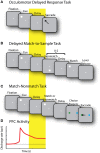Role of Prefrontal Persistent Activity in Working Memory
- PMID: 26778980
- PMCID: PMC4700146
- DOI: 10.3389/fnsys.2015.00181
Role of Prefrontal Persistent Activity in Working Memory
Abstract
The prefrontal cortex is activated during working memory, as evidenced by fMRI results in human studies and neurophysiological recordings in animal models. Persistent activity during the delay period of working memory tasks, after the offset of stimuli that subjects are required to remember, has traditionally been thought of as the neural correlate of working memory. In the last few years several findings have cast doubt on the role of this activity. By some accounts, activity in other brain areas, such as the primary visual and posterior parietal cortex, is a better predictor of information maintained in visual working memory and working memory performance; dynamic patterns of activity may convey information without requiring persistent activity at all; and prefrontal neurons may be ill-suited to represent non-spatial information about the features and identity of remembered stimuli. Alternative interpretations about the role of the prefrontal cortex have thus been suggested, such as that it provides a top-down control of information represented in other brain areas, rather than maintaining a working memory trace itself. Here we review evidence for and against the role of prefrontal persistent activity, with a focus on visual neurophysiology. We show that persistent activity predicts behavioral parameters precisely in working memory tasks. We illustrate that prefrontal cortex represents features of stimuli other than their spatial location, and that this information is largely absent from early cortical areas during working memory. We examine memory models not dependent on persistent activity, and conclude that each of those models could mediate only a limited range of memory-dependent behaviors. We review activity decoded from brain areas other than the prefrontal cortex during working memory and demonstrate that these areas alone cannot mediate working memory maintenance, particularly in the presence of distractors. We finally discuss the discrepancy between BOLD activation and spiking activity findings, and point out that fMRI methods do not currently have the spatial resolution necessary to decode information within the prefrontal cortex, which is likely organized at the micrometer scale. Therefore, we make the case that prefrontal persistent activity is both necessary and sufficient for the maintenance of information in working memory.
Keywords: fMRI; monkey; neuron; neurophysiology; prefrontal cortex.
Figures




Similar articles
-
Decoding working memory information from neurons with and without persistent activity in the primate prefrontal cortex.J Neurophysiol. 2023 Dec 1;130(6):1392-1402. doi: 10.1152/jn.00290.2023. Epub 2023 Nov 1. J Neurophysiol. 2023. PMID: 37910532 Free PMC article.
-
Decoding working memory information from persistent and activity-silent neurons in the primate prefrontal cortex.bioRxiv [Preprint]. 2023 Jul 28:2023.07.25.550371. doi: 10.1101/2023.07.25.550371. bioRxiv. 2023. Update in: J Neurophysiol. 2023 Dec 1;130(6):1392-1402. doi: 10.1152/jn.00290.2023. PMID: 37546782 Free PMC article. Updated. Preprint.
-
Contributions of narrow- and broad-spiking prefrontal and parietal neurons on working memory tasks.Front Syst Neurosci. 2024 Mar 21;18:1365622. doi: 10.3389/fnsys.2024.1365622. eCollection 2024. Front Syst Neurosci. 2024. PMID: 38577690 Free PMC article.
-
Working Memory in the Prefrontal Cortex.Brain Sci. 2017 Apr 27;7(5):49. doi: 10.3390/brainsci7050049. Brain Sci. 2017. PMID: 28448453 Free PMC article. Review.
-
The role of prefrontal cortex in working memory: examining the contents of consciousness.Philos Trans R Soc Lond B Biol Sci. 1998 Nov 29;353(1377):1819-28. doi: 10.1098/rstb.1998.0334. Philos Trans R Soc Lond B Biol Sci. 1998. PMID: 9854254 Free PMC article. Review.
Cited by
-
Strategy-dependent effects of working-memory limitations on human perceptual decision-making.Elife. 2022 Mar 15;11:e73610. doi: 10.7554/eLife.73610. Elife. 2022. PMID: 35289747 Free PMC article.
-
Persistent neuronal activity in human prefrontal cortex links perception and action.Nat Hum Behav. 2018 Jan;2(1):80-91. doi: 10.1038/s41562-017-0267-2. Epub 2017 Dec 18. Nat Hum Behav. 2018. PMID: 29963646 Free PMC article.
-
Pinging the brain to reveal hidden memories.Nat Neurosci. 2017 May 25;20(6):767-769. doi: 10.1038/nn.4560. Nat Neurosci. 2017. PMID: 28542151 Free PMC article.
-
Effects of Lisdexamfetamine, a Prodrug of D-Amphetamine, on Locomotion, Spatial Cognitive Processing and Neurochemical Profiles in Rats: A Comparison With Immediate-Release Amphetamine.Front Psychiatry. 2022 Apr 26;13:885574. doi: 10.3389/fpsyt.2022.885574. eCollection 2022. Front Psychiatry. 2022. PMID: 35558431 Free PMC article.
-
Emergence of prefrontal neuron maturation properties by training recurrent neural networks in cognitive tasks.iScience. 2021 Sep 27;24(10):103178. doi: 10.1016/j.isci.2021.103178. eCollection 2021 Oct 22. iScience. 2021. PMID: 34667944 Free PMC article.
References
-
- Atkinson R. C., Shiffrin R. M. (1968). Human memory: a proposed system and its control processes, in The Psychology of Learning and Motivation, eds Spence K. W., Spence J. T. (London: Academic Press; ), 89–195.
Publication types
Grants and funding
LinkOut - more resources
Full Text Sources
Other Literature Sources
Miscellaneous

